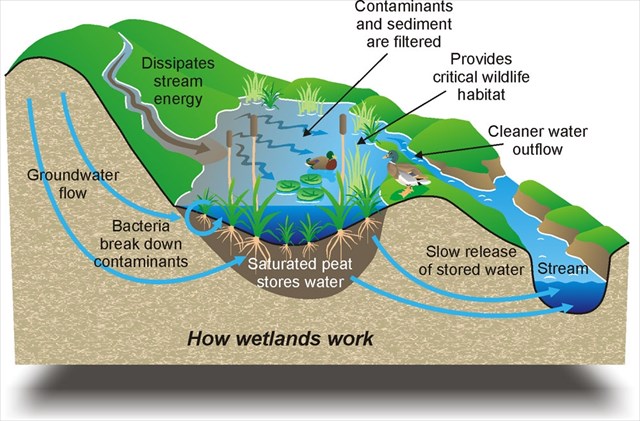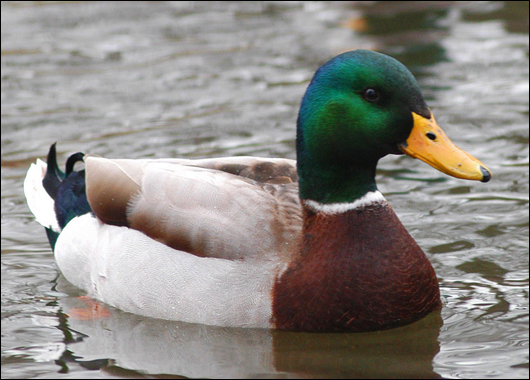Why Wetlands?
Long regarded as wastelands, wetlands have now become recognized as important landscapes that provide beneficial services to humans, fish and wildlife. Some of the services include protecting and improving water quality, habitats, reduce flooding, and maintaining surface water flow during dry periods. Wetland destruction is not just disastrous to the species of plants and animals that inhabit them, but for humans as well.
Storm and Flood Water Storage
Many people fail to realize the role wetlands play in preventing flooding. Wetlands function like giant natural tubs or sponges. Wetlands collect excess water after storms and slowly release the water in a way in which flooding does not occur. This process decelerates the water’s momentum, erosion potential, flood heights, and allows for ground water recharge. Ground water recharge helps contribute to the flow of surface water systems during dry periods. Low areas are more likely to become flooded after wetlands are diminished and this could be terrible for business and home owners (WDNR 1998).
Shoreline Stabilization
Wetlands along the shorelines of lakes or river banks help protect the shoreline soils from erosive forces such as waves and currents. The wetland plants that grow along the shorelines and banks, act as a buffer zone by dispersing the water's energy and providing stability by combining the soils with their roots. Without wetlands along the shorelines and river banks,shoreline erosion can cause significant problems for waterfront property owners. If wetlands did not exist along shorelines and river banks, our shorelines would become bare and muddy flats, poor water quality, loss of wildlife and the destruction of property (WDNR 1998).
Water Quality

http://myweb.rollins.edu/jsiry/Wetland_Global-educat-change_Essays.html
Animal Life
The wetlands in Wisconsin, themselves house many birds, mammals, and amphibians that would go extinct in the area if the wetlands were to disappear. The loss of these creatures would mean a loss in biological diversity. With the loss of biological diversity, this would be a permanent scar in the state of Wisconsin because biodiversity provides a stable environment for the native species. Many plant species also exist only in the wetlands. The loss of the wetlands would cause many insect and amphibian species to decline dramatically. This would result in a vital part of the food chain to be wrecked and this would also affect the animals in neighboring environments as well. Amphibians in particular thrive especially well in small wetlands which makes them a critical part of the environment (WDNR 1998).
Waterfowl
North American wetlands provide the habitat for many species of waterfowl. Small wetlands in particular are very important to waterfowl diversity, especially ducks. Ducks are territorial, which means, small wetlands are necessary for them to breed as opposed to large ones. For example there would be more nesting ducks in three one-acre wetlands than one big three-acre wetland. If small wetlands were to disappear it would be disastrous economically. This would decrease the duck population to the point where it would reduce the annual duck harvest as well as result in the loss of hunting days. With the reduced duck harvest and hunting days, this would result in $22.2 million in lost hunter expenditures (WDNR 1998).

http://animal.discovery.com/guides/wild-birds/i-r/mallard-duck.html
Fish
Wetlands connected to the surface waters of lakes, rivers and ponds, are critical in the spawning of many species of fish. With the destruction of the wetlands the populations of many sport fish have fallen to levels where hatchery raised fish often have to be brought in. However, even with hatchery raised fish, fish are unable to restore the fish population to what it was before (WDNR 1998).

